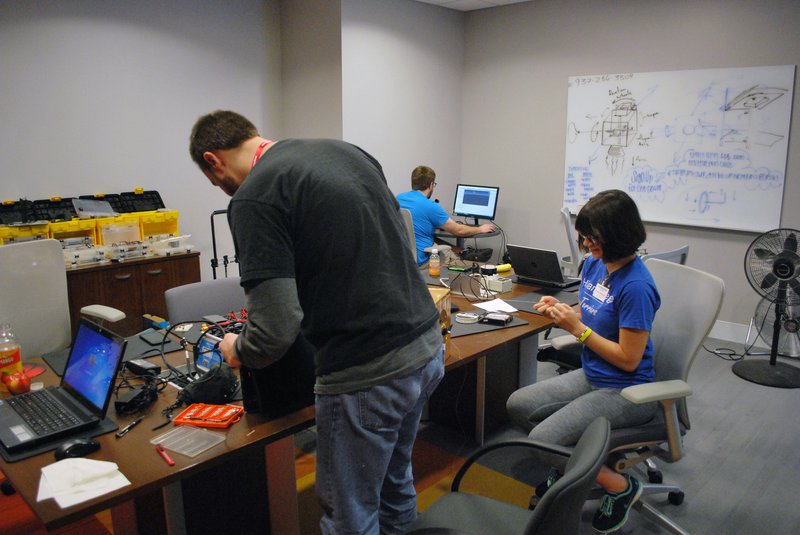Moon Tang Clan | Space Jockey
Awards & Nominations
Moon Tang Clan has received the following awards and nominations. Way to go!
The Challenge | Space Jockey
Da' Mystery of Spaceboxin'
Personal reusable cube satellite for exploration and experimentation. Spaceboxin’ allows an individual to launch and navigate a personal satellite into space. The user will interact with the satellite using a virtual environment simulated using the Oculus.

The Moon Tang Clan is back with our new creation, Da Mystery of Spaceboxin'
Near Space Reusable Personal Satellite ( ಠ ͜ʖರೃ)
Experience space for yourself
Personal reusable cube satellite for exploration and experimentation. Spaceboxin’ allows an individual to launch and navigate a personal satellite into space. The user will interact with the satellite using a virtual environment simulated using the Oculus Rift. With the Oculus, the pilot will be able to experience actual space in all of it’s glory. The craft will be guided on a predefined route with the option for the user to take control of the orientation and direction of Spaceboxin’ through the Earth’s outer atmosphere.
The balloon is filled with helium to create lift. Helium is non-flammable, non-toxic to the atmosphere and a safe, predictable method of ascent. As the balloon ascends, the helium will expand and the balloon will slowly fill out to an almost completely round shape. The balloon is constructed of strips of high-performance polyethylene (plastic) film that is only 0.0008 inches thick. In total, these strips would cover 40 acres if they were laid flat. Polyester-fibre reinforced load tapes are incorporated to do the weight bearing.
We will be using Hydrogen peroxide as an in-flight propellant because it is inexpensive, environmentally friendly, and extremely effective for our purpose.
Launch
- Considerations for launch ( preparation is the key to success!)
Launches typically occur in the the morning to take advantage of stable atmospheric conditions.
- Before launch a wide range of data needs to be collected. This includes wind speed and direction at different altitudes, temperature, solar radiation exposure, storm conditions, pressure, etc...
- A predicted path of the craft will be calculated by utilizing the data from atmospheric conditions and information on the payload.
- Typically if wind speed between the ground and 700ft reach above 2mph we will not launch.
- To reduce the amount of turbulence the ascent will not exceed 5 meters per second. (How do you control this?)
- The balloon will ascend at about 700 feet per minute. At some points, its ascent could be as fast as 1,400 feet per minute. Upon reaching about 100,000 feet, however, it will likely slow to roughly 750 feet per minute until it levels off at approximately 120,000 feet above sea level.
- Ultimately we want to try and maximize the suspension line from the balloon to the parachute. This means that any movement by the balloon is dissipated before it reaches the parachute and payload. In short the longer the line the less jerky the footage. Of course we don’t want to go too long as this can reduce control when launching
- How is the balloon steered?
- Wind is used to direct a balloon's trajectory during the ascent phase. Wind speed and direction vary at different altitudes so balloons are steered by changing altitude to reach the desired wind conditions. Releasing helium causes a decrease in altitude, while dropping ballast allows a balloon to rise. While at float altitude and even while ascending, propellant and reaction wheels will be used to orient and move the craft in order to maintain its planned course.
- How does the balloon avoid other aircraft in the sky?
- In the United States, the U.S. Federal Aviation Administration clearance will have to be obtained to launch the craft into the Earth’s atmosphere. A flight plan will have to be documented and the craft can be tracked using GPS, radio signals, and a special reflective tape that can be seen on radar.
Float Altitude / In flight
- A release valve will have to be installed in the balloon in order to dissipate gas as it expands in its ascent.
- Float altitude(top altitude), where low air pressure will cause the helium to expand so much that if the excess cannot escape through the balloon's vent tubes, it will burst. Helium inflation quantities are carefully calculated to avoid this.
- We will be use a single mounted thruster in order to generate the force needed to accelerate the craft through space.
- Utilizes a reaction wheel to control the attitude (the orientation) of the craft
- Balloons cannot be re-used. In fact, once the balloon is even taken out of its box it must be launched promptly or discarded.
- Ground based tracking (prediction engine: http://predict.habhub.org/)
Re-entry
- We plan to guide the Satellite to safe-zone via Predictive models using known wind patterns, atmospheric density, spin of the earth and geo-coordinates. The reaction wheel, thrusters, and parachute will protect the craft during reentry and guide it to the safe zone for landing.
- Flight patterns, weather conditions, and location are all considerations we will have to take into account for reentry
- A ground landing will require a safe zone of an approximate 30 mile radius. We will have to avoid personal property, humans, animals, property and environmental damage.
- A water landing would require knowledge of shipping patterns, a floatation device, and ecological data to avoid potential damage to the environment.
Recovery & Reuse
- Recovery systems exist using existing GPS / SMS tracking systems
- Adafruit Ultimate GPS works up to 60,000ft. Will be used for in-flight tracking
- Garmin 18x OEM works to 100,000ft
- Ublox GPS works up to 150,000ft
- Tracksoar is the smallest lightest open source APRS tracker available. https://www.tracksoar.com/
Further/Future Applications
- Augmented reality
- Microgravity experiments
- Constellation, country, or planetary overlay including supplementary data
Moon Tang 4-eva
Our github:
www.github.com/nlinscott/MysteryOfSpaceBoxin
SpaceApps is a NASA incubator innovation program.